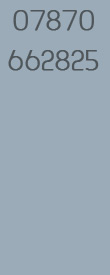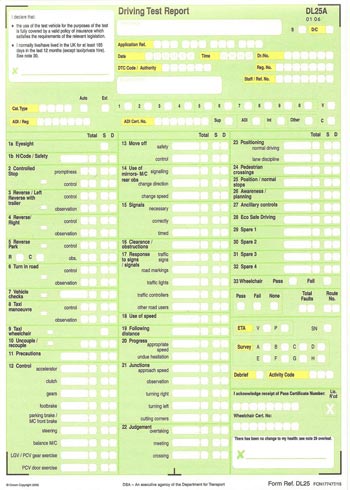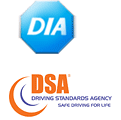 |
THE DRIVING TESTTHE THEORY TESTThe theory test is a combination of a multiple-choice question section and a hazard perception test, both of which have to be passed in the same sitting otherwise both will have to be re-taken. The multiple-choice section comprises of 50 multiple-choice questions (selected randomly from a bank of over 1200 questions) of which you will have to answer 43 questions correctly to pass. You can practice for the multiple-choice part of the theory test online at: www.theory-tests.co.uk The hazard perception test involves being presented with 14 video clips of approximately one minute each, which feature everyday road scenes, filmed as though you are in the driver's seat. In each clip there will be a number of potential hazards of which one will develop into an actual hazard; one of the clips will feature two developing hazards. The idea is to respond by clicking the mouse button of the computer during the early part of a hazard's development; the quicker you react, the better your score. Candidates can score up to five marks on each hazard and the test contains fifteen score-able hazards. You have to score 44 out of a potential 75 points to pass. Practice for this part of the exam is recommended as many people find a number of goes are required to get the hang of it. At the end of the test, you will be given your result by the test centre staff. If you pass, you will receive your theory test certificate, which has your theory test certificate number on; this number will be required when booking your practical test. The theory test certificate is valid for two years from the date of your test. If you do not successfully pass the practical test within this two-year period, you will have to re-take the theory test. If you fail, be sure to look at the feedback given on the letter to try and help identify why you failed. You can book another test straight away but you cannot take it for another three clear working days.
THE PRACTICAL TESTDocuments needs for the driving testDRIVING LICENSE: You must be able to present both parts of your provisional driving license (the card and the counterpart) to the examiner on the day of the driving test. Failure to do so will result in your test being terminated and your test fee lost. THEORY CERTIFICATE: Although you wouldn't have been able to book your practical driving test without a valid theory certificate pass number, the DSA ask you to bring your certificate along in case checks are needed on their system. LETTER OF APPOINTMENT: It is advisable to bring along your letter of appointment as proof that you are supposed to be there on that day at that time just in case there has been a mistake processing your booking and there is not an examiner available to take you on test (This is very unlikely but has been known to happen). HOW IS THE DRIVING TEST CONDUCTED?You should arrive at the test centre approximately ten minutes before the commencement of your test and wait in the test centre waiting room- have your license at hand and if you have a mobile phone, be sure to turn it off. The examiners will enter the waiting room at the time of your test and one of them should call out your name. You then will be asked for your driving license and will be asked to sign a declaration that the car being used for the driving test is fully insured. The examiner will then ask you to show him to your car. Having introduced him or her to you on the way out of the test centre, the examiner will first conduct an eyesight test by way of asking you to read a number plate at the designated distance of 20.5 meters. If you cannot adequately read the number plate at this distance the examiner will not take you on test, so it is vitally important that you are sure your vision is satisfactory. Your driving instructor will check this for you on your first lesson. Once you have completed the eyesight test, the examiner will ask you two basic maintenance questions from a list (full list here).
For one of the questions he will ask you to tell him how you would check something to do with your cars maintenance. This of course only requires a verbal answer. For the other question he will ask you to show him how you would do something; this requires you to physically show him. If you fail to answer either one of the questions successfully you will only be penalised with one minor driving fault. Once you have completed the maintenance questions, you will be asked to get in your car (if you are not so already) whilst the examiner logs the car's details and checks that all the tyres comply with the legal requirements. ( note: If you are using your own car for the test, the tyres have to be well over the legal limit of 1.6mm tread depth with no cuts or bulges in the side wall of the tyre. Your car also has to have a head restraint and attachable a rear-view mirror for the examiner and standard L plates both front and rear). Once inside the car, the examiner will explain in brief how the test will be conducted and that he would like you to follow the road ahead, via road markings and road signs, unless indicated otherwise. (Therefore if you approach a mini-roundabout for example during the test and the examiner remains silent, this means that you should follow the road ahead). He will then ask you to start the car when you are ready and the driving test will begin. You will set out of the test centre and embark upon one of sixteen carefully planned out routes. These can be obtained from the DSA's website www.dsa.gov.uk . All you need to do is search for the appropriate test centre and then all sixteen routes will be downloadable. The driving test will last for around 35-40 minutes, during which you cover a variety of typical road and traffic conditions and will be asked to complete one set vehicle manoeuvre. There is also a one in three chance of being asked to perform an emergency stop. Since the 4th October 2010, the practical driving test also includes
a section of Independent Driving. This will consist of about ten
minutes where you will be asked to either follow a set of directions/road
signs or a combination of the two. If you are asked to follow
a set of directions, the examiner will show you a diagram showing
the desired route. If you do happen to forget where you are going,
you can ask the examiner to confirm without penalization. Even
if you take a wrong turn on the independent driving section, so
long as you do so safely you will not be penalized either. The examiner will record your progress throughout the test on the DL25A driving test report form. This covers the categories that the DSA examiner will be considering whilst observing your driving ability, ranging from all the aspects involved in smoothly controlling a car (e.g. clutch, gears, steering etc.), to how you deal with various junctions, observational skills, reaction to other road users, through to all your manoeuvres etc. You are allowed up to fifteen minor faults. However, if you are to accumulate three or more minor faults in the same category then the examiner is likely to deem this a habitual problem and so it can amount, at his or her discretion, to constitute a serious fault and result in failure. You are not allowed any serious or dangerous faults on the driving test; one of either will result in failure. Also if the examiner feels that you are a real danger to other road users then he or she can terminate the driving test at any moment throughout its duration.
HOW DO THEY DETERMINE WHAT IS A MINOR, SERIOUS OR DANGEROUS FAULT?If we take as an example turning right from a major road into a minor road, it should clarify how they judge the severity of a particular fault. Minor fault: Approaching to turn right from a major road into a minor road, you are looking ahead for oncoming traffic and can see it is clear. You follow the MSPSL routine: checking your mirrors effectively, indicating at an appropriate distance, positioning just left of the centre line, slowing down to an appropriate speed and selecting the correct gear. Before turning you have a careful look into the road to ensure it is safe and clear, yet as you steer into the road, you slightly cut across the corner of the wrong side. This would usually amount to a minor fault as although your positioning was incorrect, due to possibly turning too soon, you had ensured the road you were entering was clear of traffic. Serious fault: Take the same example but imagine that before turning you hadn’t looked into the road to ensure it was safe and clear. It would be only down to luck that there hadn’t been a car and so it would be deemed potentially dangerous. Dangerous fault: Again, imagine the same as the serious fault where you hadn’t looked effectively into the road you were entering, but this time there was a car and the examiner had to take evasive action to prevent a collision. If you passIf you pass and have a photocard driving license issued after the 1 st March 2004, the examiner will ask you if you would like your full license issued to you automatically. The examiner will take your old license from you and you will be given a pass certificate as proof that you have passed. Your full driving license will then be sent to you by the DVLA within four weeks. If you have a license issued to you before 1 st March 2004, you will be given a pass certificate by the examiner. On the back of the pass certificate are instructions regarding how to go about obtaining your full license. If you failIf you fail, your examiner will explain that they are sorry, but that you haven’t reached the required standard for the driving test. He or she will then offer you feedback and ask whether you would like your instructor to listen in. This is always a good idea as you may find that through nerves and disappointment you will fail to adequately take on board all the information accurately. You will also be given a copy of the driving test report form detailing your driving errors. You can book another driving test immediately but will not be able to take another test within 10 days of your original test. CancellationsYou may worry, what with such long waiting times at particular test centres that you will have a long wait before being able to re-take the driving test. Not necessarily. All the time people cancel their driving test date appointment for a number of reasons, not least because they realise that they have not reached the required standard in time. When they cancel their date, it will become available for you to pick up. This happens a number of times everyday and so if you are regularly checking, you will be able to change your time to the earlier option. You are allowed to do this three times before loosing your fee.
THE 10 MOST COMMON REASONS FOR DRIVING TEST FAILURE
Reported by the Driving Standards Agency for the 12 months to January 2004
TEST ROUTES
Test route information for all driving test centres can be found at WWW.DSA.GOV.UK Back / Getting Started / Driving Test / Recommended Reading
|


